sensor MINI 3 door 2013 User Guide
[x] Cancel search | Manufacturer: MINI, Model Year: 2013, Model line: 3 door, Model: MINI 3 door 2013Pages: 233, PDF Size: 17.19 MB
Page 104 of 233

▷When using high-pressure washers, do not
spray the sensors for long periods and
maintain a distance of at least 12 in/30 cm.
Parking assistant
The concept
This system assists the driver in parking parallel
to the road.
Ultrasound sensors measure parking spaces on
both sides of the vehicle.
The parking assistant calculates the best possi‐
ble parking line and takes control of steering
during the parking procedure.
When parking, also take note of the visual and
acoustic information issued by the PDC and the
parking assistant and accelerate or brake ac‐
cordingly.
A component of the parking assistant is the
PDC Park Distance Control, refer to page 98.
Hints Personal responsibility
Even an active system does not relieve
the driver from personal responsibility for the
driving process.
Because of technical system limits, the system
cannot independently react appropriately in all
traffic situations.
Continuously and attentively monitor the driv‐
ing process, the area surrounding the vehicle
and the traffic situation, and actively intervene
when required, otherwise, there is a risk of an
accident. ◀
Changes to the parking space
Changes to the parking space after it was
measured are not taken into account by the
system.
Therefore, always be alert and ready to inter‐
vene; otherwise, there is the danger of an acci‐
dent occurring. ◀
Transporting loads
Loads that extend beyond the perimeter
of the vehicle are not taken into account by the
system during the parking procedure.
Therefore, always be alert and ready to inter‐
vene; otherwise, there is the danger of an acci‐
dent occurring. ◀
Curbs
The parking assistant may steer the vehi‐
cle over or onto curbs.
Therefore, always be alert and ready to inter‐
vene; otherwise, the wheels, tires, or the vehi‐
cle may become damaged. ◀
An engine that has been switched off by the
Auto Start Stop function is restarted automati‐
cally when the parking assistant is activated.
Requirements
For measuring parking spaces▷Maximum speed while driving forward ap‐
prox. 22 mph/35 km/h.▷Maximum distance to row of parked vehi‐
cles: 5 ft/1.5 m.▷When parking in parking spaces on the
driver's side, the corresponding turn signal
must be set.Seite 100ControlsDriving comfort100
Online Edition for Part no. 01 40 2 925 116 - X/13
Page 105 of 233
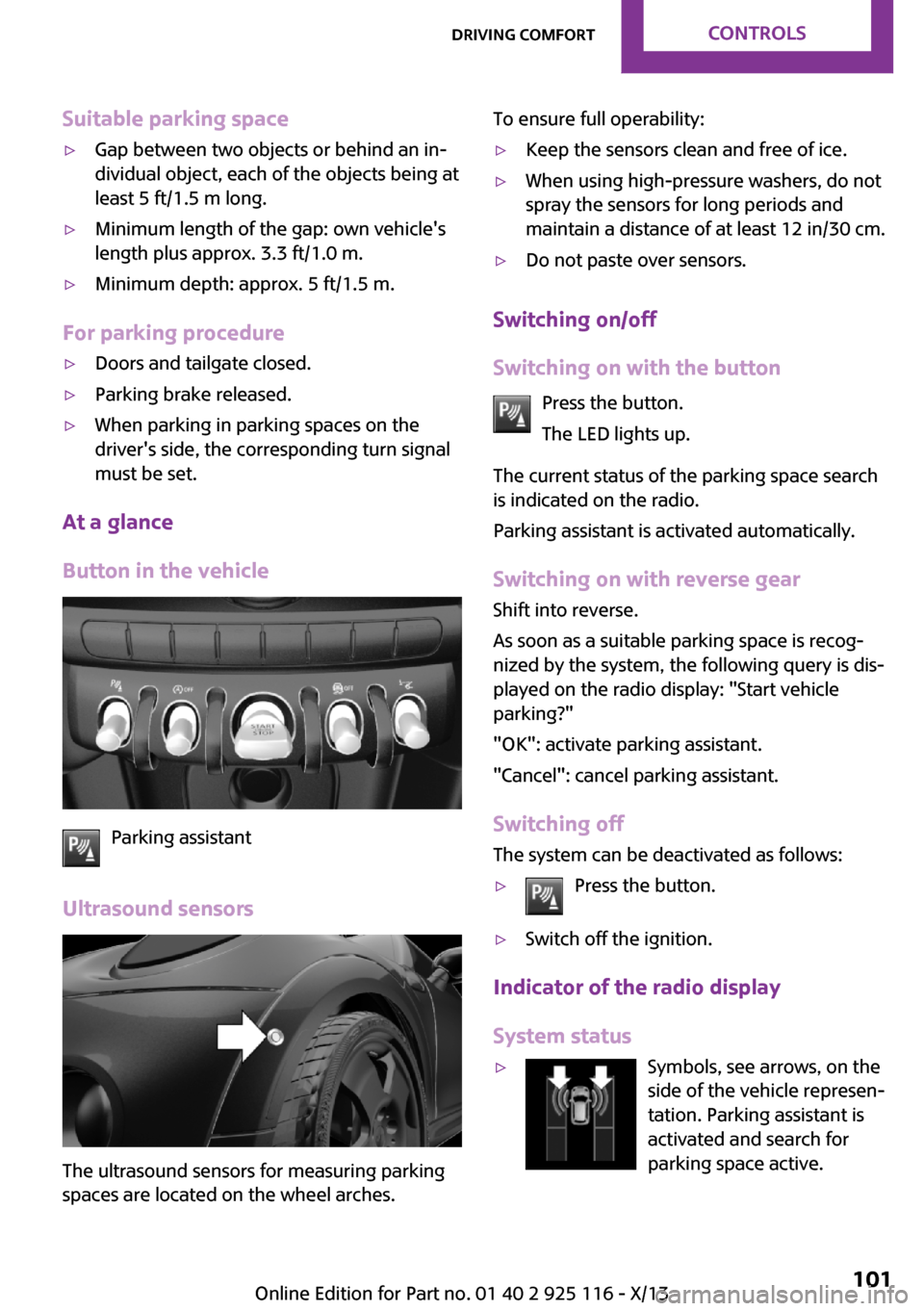
Suitable parking space▷Gap between two objects or behind an in‐
dividual object, each of the objects being at
least 5 ft/1.5 m long.▷Minimum length of the gap: own vehicle's
length plus approx. 3.3 ft/1.0 m.▷Minimum depth: approx. 5 ft/1.5 m.
For parking procedure
▷Doors and tailgate closed.▷Parking brake released.▷When parking in parking spaces on the
driver's side, the corresponding turn signal
must be set.
At a glance
Button in the vehicle
Parking assistant
Ultrasound sensors
The ultrasound sensors for measuring parking
spaces are located on the wheel arches.
To ensure full operability:▷Keep the sensors clean and free of ice.▷When using high-pressure washers, do not
spray the sensors for long periods and
maintain a distance of at least 12 in/30 cm.▷Do not paste over sensors.
Switching on/off
Switching on with the button Press the button.
The LED lights up.
The current status of the parking space search
is indicated on the radio.
Parking assistant is activated automatically.
Switching on with reverse gear
Shift into reverse.
As soon as a suitable parking space is recog‐ nized by the system, the following query is dis‐
played on the radio display: "Start vehicle
parking?"
"OK": activate parking assistant.
"Cancel": cancel parking assistant.
Switching off The system can be deactivated as follows:
▷Press the button.▷Switch off the ignition.
Indicator of the radio display
System status
▷Symbols, see arrows, on the
side of the vehicle represen‐
tation. Parking assistant is
activated and search for
parking space active.Seite 101Driving comfortControls101
Online Edition for Part no. 01 40 2 925 116 - X/13
Page 106 of 233
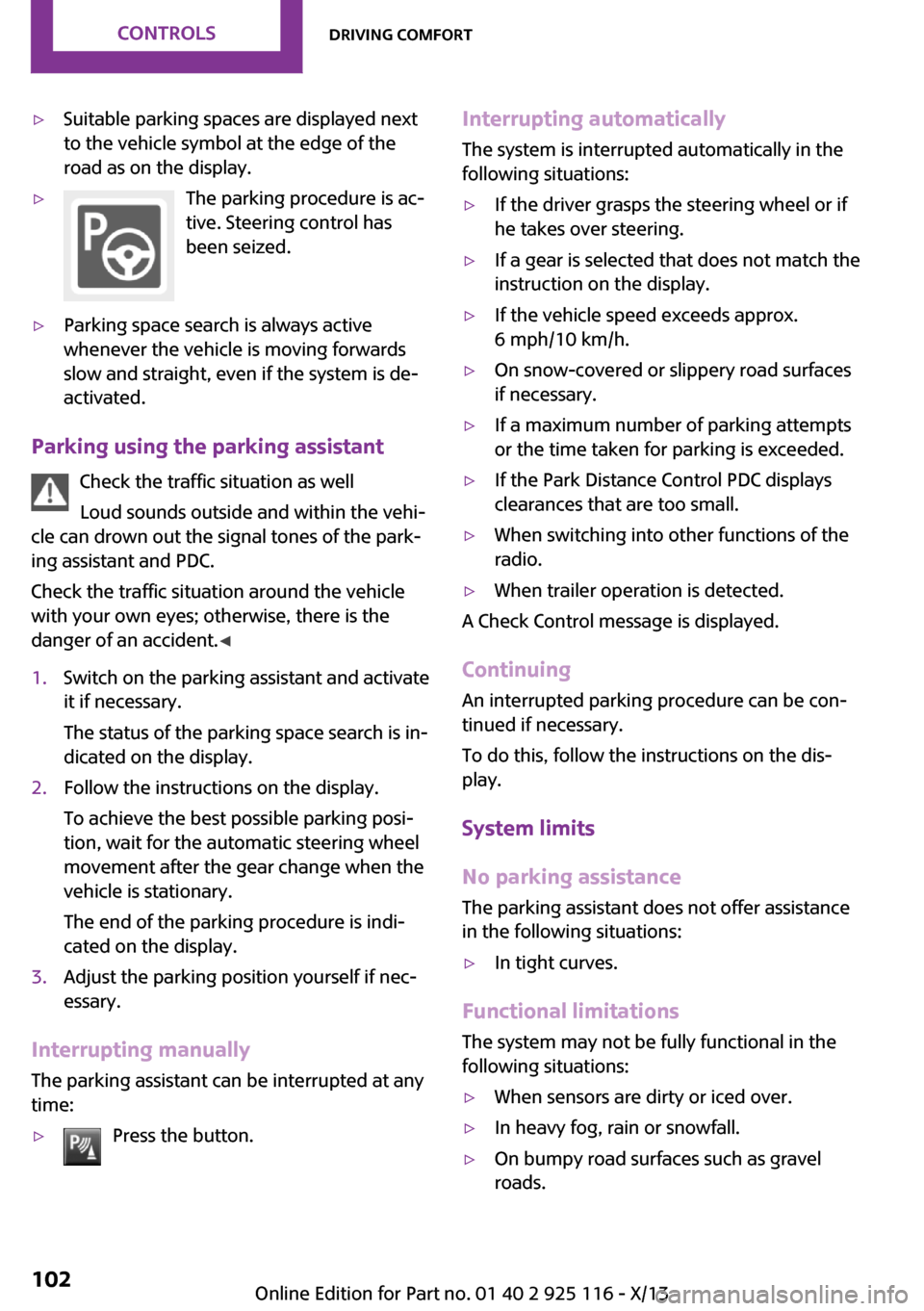
▷Suitable parking spaces are displayed next
to the vehicle symbol at the edge of the
road as on the display.▷The parking procedure is ac‐
tive. Steering control has
been seized.▷Parking space search is always active
whenever the vehicle is moving forwards
slow and straight, even if the system is de‐
activated.
Parking using the parking assistant
Check the traffic situation as well
Loud sounds outside and within the vehi‐
cle can drown out the signal tones of the park‐
ing assistant and PDC.
Check the traffic situation around the vehicle
with your own eyes; otherwise, there is the
danger of an accident. ◀
1.Switch on the parking assistant and activate
it if necessary.
The status of the parking space search is in‐
dicated on the display.2.Follow the instructions on the display.
To achieve the best possible parking posi‐
tion, wait for the automatic steering wheel
movement after the gear change when the
vehicle is stationary.
The end of the parking procedure is indi‐
cated on the display.3.Adjust the parking position yourself if nec‐
essary.
Interrupting manually
The parking assistant can be interrupted at any
time:
▷Press the button.Interrupting automatically
The system is interrupted automatically in the
following situations:▷If the driver grasps the steering wheel or if
he takes over steering.▷If a gear is selected that does not match the
instruction on the display.▷If the vehicle speed exceeds approx.
6 mph/10 km/h.▷On snow-covered or slippery road surfaces
if necessary.▷If a maximum number of parking attempts
or the time taken for parking is exceeded.▷If the Park Distance Control PDC displays
clearances that are too small.▷When switching into other functions of the
radio.▷When trailer operation is detected.
A Check Control message is displayed.
Continuing
An interrupted parking procedure can be con‐
tinued if necessary.
To do this, follow the instructions on the dis‐
play.
System limits
No parking assistance The parking assistant does not offer assistance
in the following situations:
▷In tight curves.
Functional limitations
The system may not be fully functional in the
following situations:
▷When sensors are dirty or iced over.▷In heavy fog, rain or snowfall.▷On bumpy road surfaces such as gravel
roads.Seite 102ControlsDriving comfort102
Online Edition for Part no. 01 40 2 925 116 - X/13
Page 107 of 233
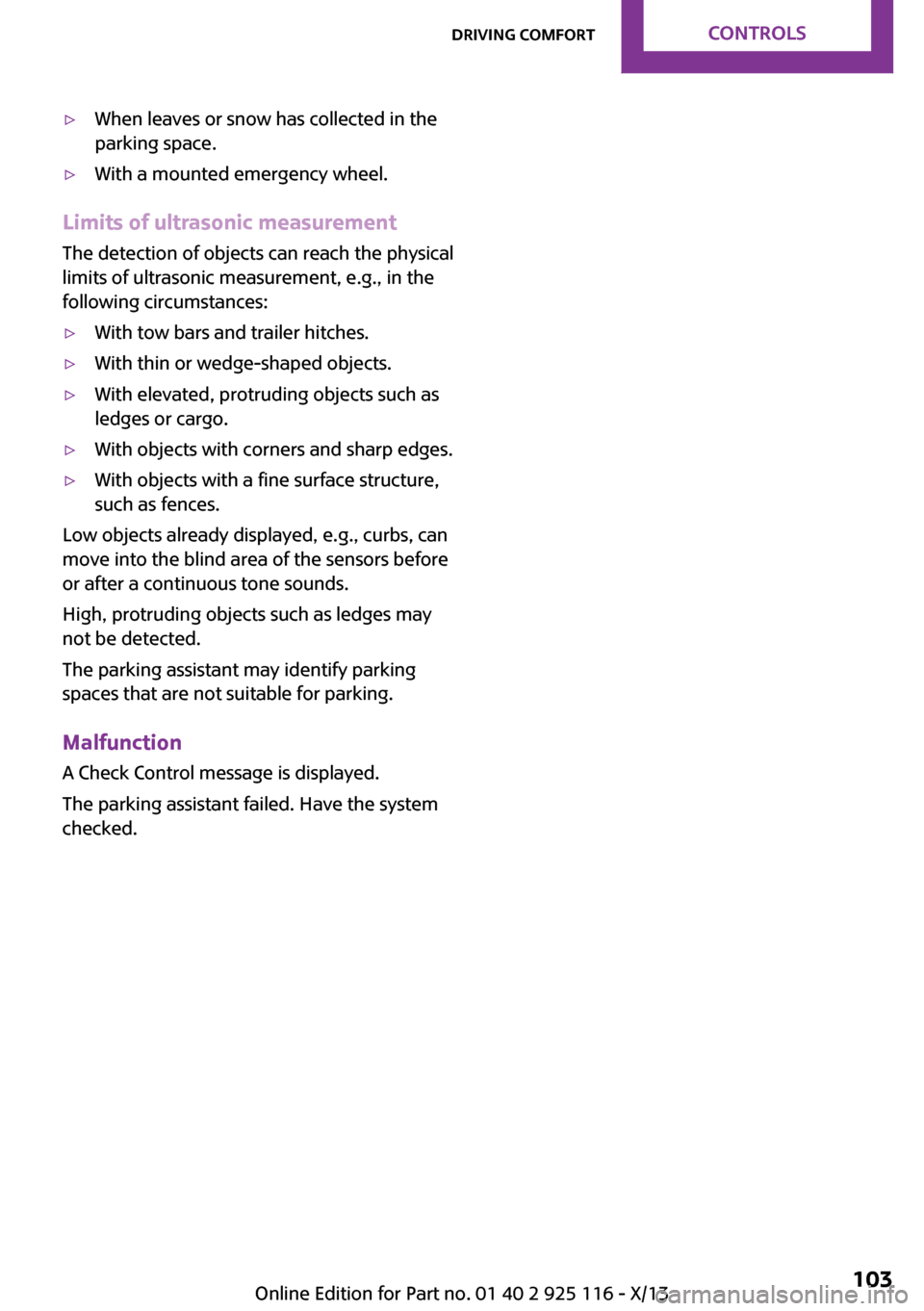
▷When leaves or snow has collected in the
parking space.▷With a mounted emergency wheel.
Limits of ultrasonic measurement
The detection of objects can reach the physical
limits of ultrasonic measurement, e.g., in the
following circumstances:
▷With tow bars and trailer hitches.▷With thin or wedge-shaped objects.▷With elevated, protruding objects such as
ledges or cargo.▷With objects with corners and sharp edges.▷With objects with a fine surface structure,
such as fences.
Low objects already displayed, e.g., curbs, can
move into the blind area of the sensors before
or after a continuous tone sounds.
High, protruding objects such as ledges may
not be detected.
The parking assistant may identify parking
spaces that are not suitable for parking.
Malfunction A Check Control message is displayed.
The parking assistant failed. Have the system
checked.
Seite 103Driving comfortControls103
Online Edition for Part no. 01 40 2 925 116 - X/13
Page 112 of 233
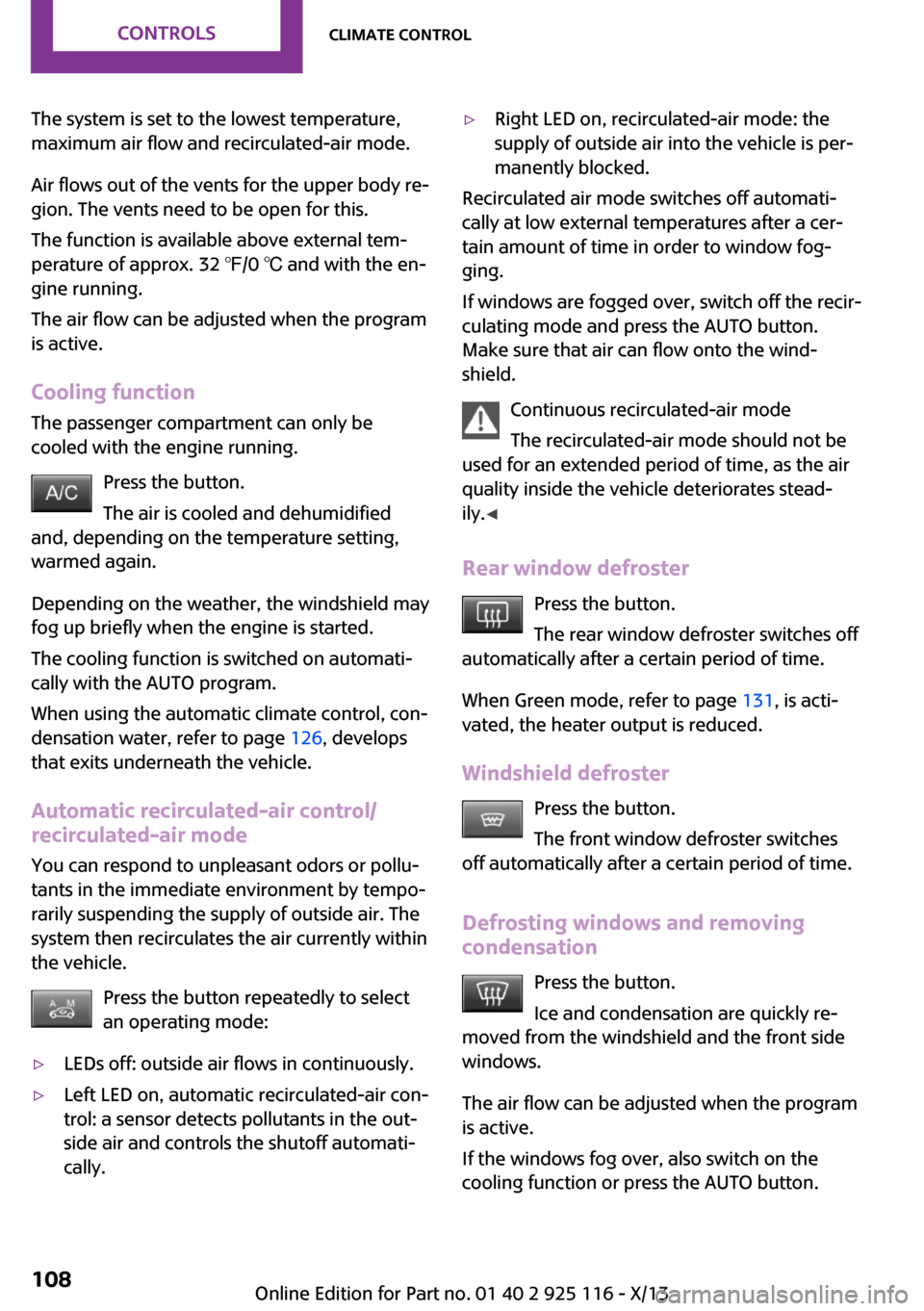
The system is set to the lowest temperature,
maximum air flow and recirculated-air mode.
Air flows out of the vents for the upper body re‐
gion. The vents need to be open for this.
The function is available above external tem‐
perature of approx. 32 ℉/0 ℃ and with the en‐
gine running.
The air flow can be adjusted when the program
is active.
Cooling function The passenger compartment can only be
cooled with the engine running.
Press the button.
The air is cooled and dehumidified
and, depending on the temperature setting,
warmed again.
Depending on the weather, the windshield may
fog up briefly when the engine is started.
The cooling function is switched on automati‐
cally with the AUTO program.
When using the automatic climate control, con‐
densation water, refer to page 126, develops
that exits underneath the vehicle.
Automatic recirculated-air control/ recirculated-air mode
You can respond to unpleasant odors or pollu‐
tants in the immediate environment by tempo‐
rarily suspending the supply of outside air. The
system then recirculates the air currently within
the vehicle.
Press the button repeatedly to select
an operating mode:▷LEDs off: outside air flows in continuously.▷Left LED on, automatic recirculated-air con‐
trol: a sensor detects pollutants in the out‐
side air and controls the shutoff automati‐
cally.▷Right LED on, recirculated-air mode: the
supply of outside air into the vehicle is per‐
manently blocked.
Recirculated air mode switches off automati‐
cally at low external temperatures after a cer‐
tain amount of time in order to window fog‐
ging.
If windows are fogged over, switch off the recir‐
culating mode and press the AUTO button.
Make sure that air can flow onto the wind‐
shield.
Continuous recirculated-air mode
The recirculated-air mode should not be
used for an extended period of time, as the air
quality inside the vehicle deteriorates stead‐
ily. ◀
Rear window defroster Press the button.
The rear window defroster switches off
automatically after a certain period of time.
When Green mode, refer to page 131, is acti‐
vated, the heater output is reduced.
Windshield defroster Press the button.
The front window defroster switches
off automatically after a certain period of time.
Defrosting windows and removing
condensation
Press the button.
Ice and condensation are quickly re‐
moved from the windshield and the front side
windows.
The air flow can be adjusted when the program
is active.
If the windows fog over, also switch on the
cooling function or press the AUTO button.
Seite 108ControlsClimate control108
Online Edition for Part no. 01 40 2 925 116 - X/13
Page 188 of 233
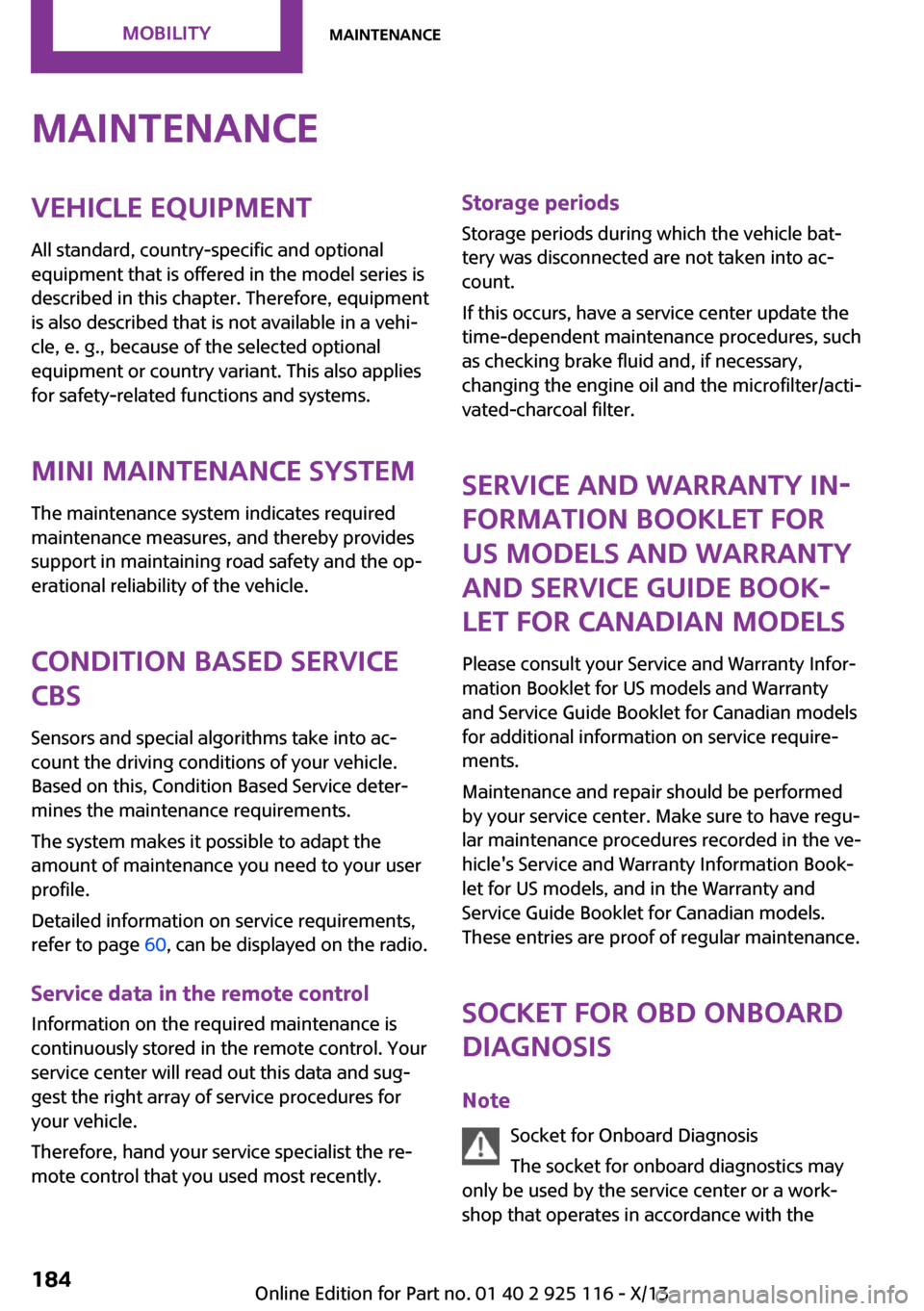
MaintenanceVehicle equipment
All standard, country-specific and optional
equipment that is offered in the model series is
described in this chapter. Therefore, equipment
is also described that is not available in a vehi‐
cle, e. g., because of the selected optional
equipment or country variant. This also applies
for safety-related functions and systems.
MINI maintenance system
The maintenance system indicates required
maintenance measures, and thereby provides
support in maintaining road safety and the op‐
erational reliability of the vehicle.
Condition Based Service
CBS
Sensors and special algorithms take into ac‐
count the driving conditions of your vehicle.
Based on this, Condition Based Service deter‐
mines the maintenance requirements.
The system makes it possible to adapt the
amount of maintenance you need to your user
profile.
Detailed information on service requirements,
refer to page 60, can be displayed on the radio.
Service data in the remote control
Information on the required maintenance is continuously stored in the remote control. Yourservice center will read out this data and sug‐
gest the right array of service procedures for
your vehicle.
Therefore, hand your service specialist the re‐
mote control that you used most recently.Storage periods
Storage periods during which the vehicle bat‐
tery was disconnected are not taken into ac‐
count.
If this occurs, have a service center update the
time-dependent maintenance procedures, such
as checking brake fluid and, if necessary,
changing the engine oil and the microfilter/acti‐
vated-charcoal filter.
Service and Warranty In‐
formation Booklet for
US models and Warranty
and Service Guide Book‐
let for Canadian models
Please consult your Service and Warranty Infor‐
mation Booklet for US models and Warranty
and Service Guide Booklet for Canadian models
for additional information on service require‐
ments.
Maintenance and repair should be performed
by your service center. Make sure to have regu‐
lar maintenance procedures recorded in the ve‐
hicle's Service and Warranty Information Book‐
let for US models, and in the Warranty and
Service Guide Booklet for Canadian models.
These entries are proof of regular maintenance.
Socket for OBD Onboard
Diagnosis
Note Socket for Onboard Diagnosis
The socket for onboard diagnostics may
only be used by the service center or a work‐ shop that operates in accordance with theSeite 184MobilityMaintenance184
Online Edition for Part no. 01 40 2 925 116 - X/13
Page 207 of 233
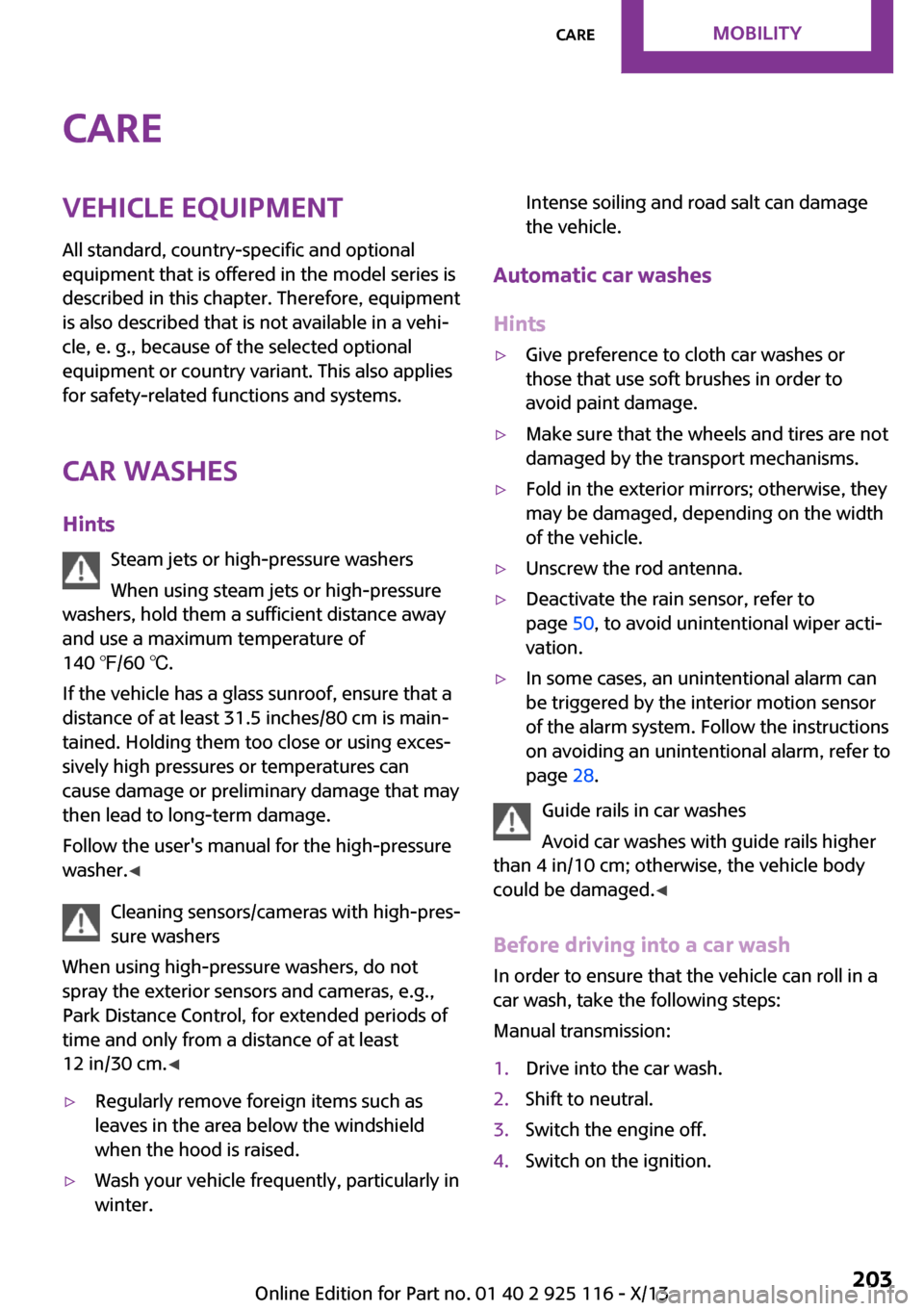
CareVehicle equipmentAll standard, country-specific and optional
equipment that is offered in the model series is
described in this chapter. Therefore, equipment
is also described that is not available in a vehi‐
cle, e. g., because of the selected optional
equipment or country variant. This also applies
for safety-related functions and systems.
Car washes
Hints Steam jets or high-pressure washers
When using steam jets or high-pressure
washers, hold them a sufficient distance away
and use a maximum temperature of
140 ℉/60 ℃.
If the vehicle has a glass sunroof, ensure that a
distance of at least 31.5 inches/80 cm is main‐
tained. Holding them too close or using exces‐
sively high pressures or temperatures can
cause damage or preliminary damage that may
then lead to long-term damage.
Follow the user's manual for the high-pressure
washer. ◀
Cleaning sensors/cameras with high-pres‐
sure washers
When using high-pressure washers, do not
spray the exterior sensors and cameras, e.g.,
Park Distance Control, for extended periods of
time and only from a distance of at least
12 in/30 cm. ◀▷Regularly remove foreign items such as
leaves in the area below the windshield
when the hood is raised.▷Wash your vehicle frequently, particularly in
winter.Intense soiling and road salt can damage
the vehicle.
Automatic car washes
Hints
▷Give preference to cloth car washes or
those that use soft brushes in order to
avoid paint damage.▷Make sure that the wheels and tires are not
damaged by the transport mechanisms.▷Fold in the exterior mirrors; otherwise, they
may be damaged, depending on the width
of the vehicle.▷Unscrew the rod antenna.▷Deactivate the rain sensor, refer to
page 50, to avoid unintentional wiper acti‐
vation.▷In some cases, an unintentional alarm can
be triggered by the interior motion sensor
of the alarm system. Follow the instructions
on avoiding an unintentional alarm, refer to
page 28.
Guide rails in car washes
Avoid car washes with guide rails higher
than 4 in/10 cm; otherwise, the vehicle body
could be damaged. ◀
Before driving into a car wash In order to ensure that the vehicle can roll in a
car wash, take the following steps:
Manual transmission:
1.Drive into the car wash.2.Shift to neutral.3.Switch the engine off.4.Switch on the ignition.Seite 203CareMobility203
Online Edition for Part no. 01 40 2 925 116 - X/13
Page 210 of 233
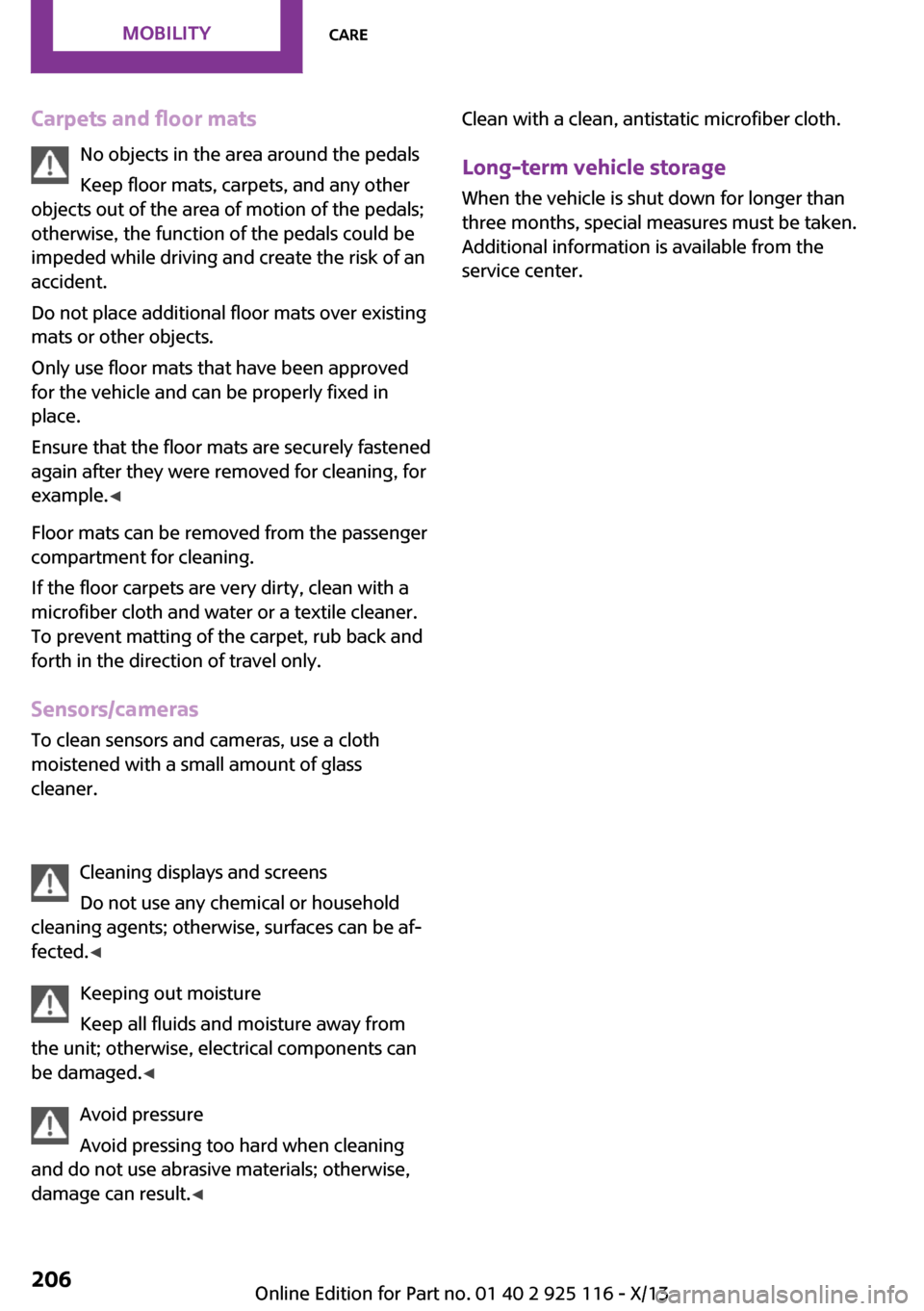
Carpets and floor matsNo objects in the area around the pedals
Keep floor mats, carpets, and any other
objects out of the area of motion of the pedals;
otherwise, the function of the pedals could be
impeded while driving and create the risk of an
accident.
Do not place additional floor mats over existing
mats or other objects.
Only use floor mats that have been approved
for the vehicle and can be properly fixed in
place.
Ensure that the floor mats are securely fastened
again after they were removed for cleaning, for
example. ◀
Floor mats can be removed from the passenger
compartment for cleaning.
If the floor carpets are very dirty, clean with a
microfiber cloth and water or a textile cleaner.
To prevent matting of the carpet, rub back and
forth in the direction of travel only.
Sensors/cameras To clean sensors and cameras, use a cloth
moistened with a small amount of glass
cleaner.
Cleaning displays and screens
Do not use any chemical or household
cleaning agents; otherwise, surfaces can be af‐
fected. ◀
Keeping out moisture
Keep all fluids and moisture away from
the unit; otherwise, electrical components can
be damaged. ◀
Avoid pressure
Avoid pressing too hard when cleaning
and do not use abrasive materials; otherwise,
damage can result. ◀Clean with a clean, antistatic microfiber cloth.
Long-term vehicle storage
When the vehicle is shut down for longer than
three months, special measures must be taken.
Additional information is available from the
service center.Seite 206MobilityCare206
Online Edition for Part no. 01 40 2 925 116 - X/13
Page 227 of 233
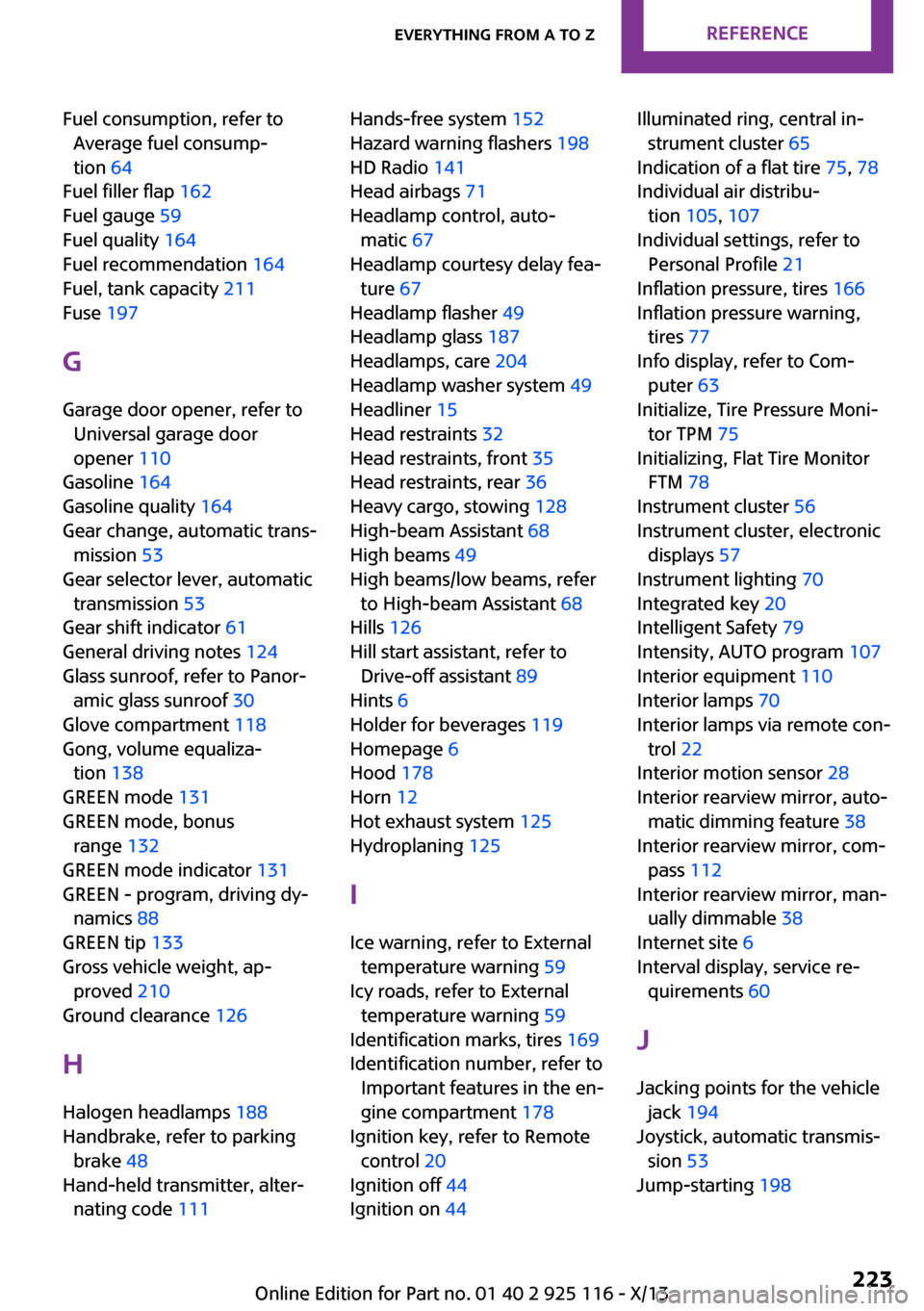
Fuel consumption, refer toAverage fuel consump‐
tion 64
Fuel filler flap 162
Fuel gauge 59
Fuel quality 164
Fuel recommendation 164
Fuel, tank capacity 211
Fuse 197
G Garage door opener, refer to Universal garage door
opener 110
Gasoline 164
Gasoline quality 164
Gear change, automatic trans‐ mission 53
Gear selector lever, automatic transmission 53
Gear shift indicator 61
General driving notes 124
Glass sunroof, refer to Panor‐ amic glass sunroof 30
Glove compartment 118
Gong, volume equaliza‐ tion 138
GREEN mode 131
GREEN mode, bonus range 132
GREEN mode indicator 131
GREEN - program, driving dy‐ namics 88
GREEN tip 133
Gross vehicle weight, ap‐ proved 210
Ground clearance 126
H Halogen headlamps 188
Handbrake, refer to parking brake 48
Hand-held transmitter, alter‐ nating code 111 Hands-free system 152
Hazard warning flashers 198
HD Radio 141
Head airbags 71
Headlamp control, auto‐ matic 67
Headlamp courtesy delay fea‐ ture 67
Headlamp flasher 49
Headlamp glass 187
Headlamps, care 204
Headlamp washer system 49
Headliner 15
Head restraints 32
Head restraints, front 35
Head restraints, rear 36
Heavy cargo, stowing 128
High-beam Assistant 68
High beams 49
High beams/low beams, refer to High-beam Assistant 68
Hills 126
Hill start assistant, refer to Drive-off assistant 89
Hints 6
Holder for beverages 119
Homepage 6
Hood 178
Horn 12
Hot exhaust system 125
Hydroplaning 125
I
Ice warning, refer to External temperature warning 59
Icy roads, refer to External temperature warning 59
Identification marks, tires 169
Identification number, refer to Important features in the en‐
gine compartment 178
Ignition key, refer to Remote control 20
Ignition off 44
Ignition on 44 Illuminated ring, central in‐
strument cluster 65
Indication of a flat tire 75, 78
Individual air distribu‐ tion 105, 107
Individual settings, refer to Personal Profile 21
Inflation pressure, tires 166
Inflation pressure warning, tires 77
Info display, refer to Com‐ puter 63
Initialize, Tire Pressure Moni‐ tor TPM 75
Initializing, Flat Tire Monitor FTM 78
Instrument cluster 56
Instrument cluster, electronic displays 57
Instrument lighting 70
Integrated key 20
Intelligent Safety 79
Intensity, AUTO program 107
Interior equipment 110
Interior lamps 70
Interior lamps via remote con‐ trol 22
Interior motion sensor 28
Interior rearview mirror, auto‐ matic dimming feature 38
Interior rearview mirror, com‐ pass 112
Interior rearview mirror, man‐ ually dimmable 38
Internet site 6
Interval display, service re‐ quirements 60
J Jacking points for the vehicle jack 194
Joystick, automatic transmis‐ sion 53
Jump-starting 198 Seite 223Everything from A to ZReference223
Online Edition for Part no. 01 40 2 925 116 - X/13
Page 229 of 233
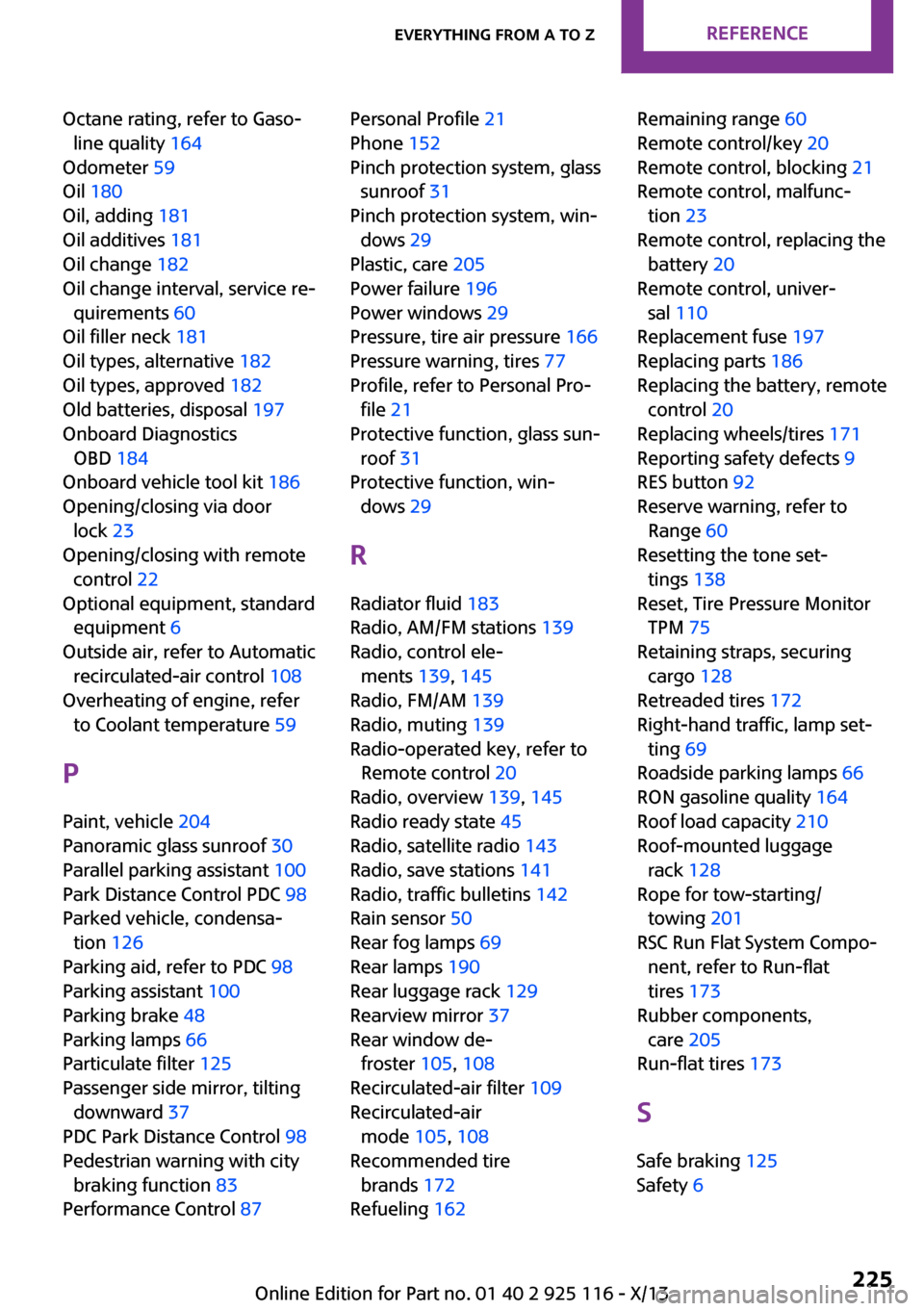
Octane rating, refer to Gaso‐line quality 164
Odometer 59
Oil 180
Oil, adding 181
Oil additives 181
Oil change 182
Oil change interval, service re‐ quirements 60
Oil filler neck 181
Oil types, alternative 182
Oil types, approved 182
Old batteries, disposal 197
Onboard Diagnostics OBD 184
Onboard vehicle tool kit 186
Opening/closing via door lock 23
Opening/closing with remote control 22
Optional equipment, standard equipment 6
Outside air, refer to Automatic recirculated-air control 108
Overheating of engine, refer to Coolant temperature 59
P Paint, vehicle 204
Panoramic glass sunroof 30
Parallel parking assistant 100
Park Distance Control PDC 98
Parked vehicle, condensa‐ tion 126
Parking aid, refer to PDC 98
Parking assistant 100
Parking brake 48
Parking lamps 66
Particulate filter 125
Passenger side mirror, tilting downward 37
PDC Park Distance Control 98
Pedestrian warning with city braking function 83
Performance Control 87 Personal Profile 21
Phone 152
Pinch protection system, glass sunroof 31
Pinch protection system, win‐ dows 29
Plastic, care 205
Power failure 196
Power windows 29
Pressure, tire air pressure 166
Pressure warning, tires 77
Profile, refer to Personal Pro‐ file 21
Protective function, glass sun‐ roof 31
Protective function, win‐ dows 29
R Radiator fluid 183
Radio, AM/FM stations 139
Radio, control ele‐ ments 139, 145
Radio, FM/AM 139
Radio, muting 139
Radio-operated key, refer to Remote control 20
Radio, overview 139, 145
Radio ready state 45
Radio, satellite radio 143
Radio, save stations 141
Radio, traffic bulletins 142
Rain sensor 50
Rear fog lamps 69
Rear lamps 190
Rear luggage rack 129
Rearview mirror 37
Rear window de‐ froster 105, 108
Recirculated-air filter 109
Recirculated-air mode 105, 108
Recommended tire brands 172
Refueling 162 Remaining range 60
Remote control/key 20
Remote control, blocking 21
Remote control, malfunc‐ tion 23
Remote control, replacing the battery 20
Remote control, univer‐ sal 110
Replacement fuse 197
Replacing parts 186
Replacing the battery, remote control 20
Replacing wheels/tires 171
Reporting safety defects 9
RES button 92
Reserve warning, refer to Range 60
Resetting the tone set‐ tings 138
Reset, Tire Pressure Monitor TPM 75
Retaining straps, securing cargo 128
Retreaded tires 172
Right-hand traffic, lamp set‐ ting 69
Roadside parking lamps 66
RON gasoline quality 164
Roof load capacity 210
Roof-mounted luggage rack 128
Rope for tow-starting/ towing 201
RSC Run Flat System Compo‐ nent, refer to Run-flat
tires 173
Rubber components, care 205
Run-flat tires 173
S
Safe braking 125
Safety 6 Seite 225Everything from A to ZReference225
Online Edition for Part no. 01 40 2 925 116 - X/13